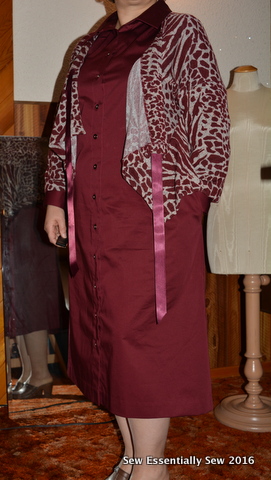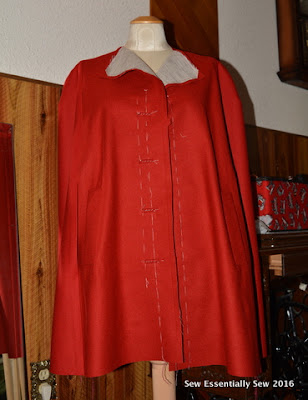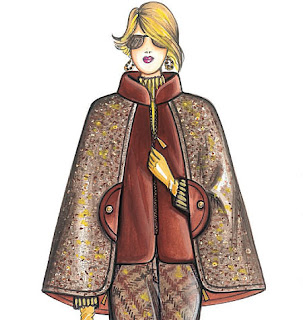After the
many mishaps it did work and I finally (and thankfully) have a shirtdress.
I used
Butterick 5760, an out-of-print (OOP) pattern that is still found on their website. So, I don't mind if you go
pick it up before you continue reading because this is one great pattern. This is only the second garment that I made with this pattern and so far, I have no complaints. I've made
the cardigan and now the dress and both patterns are well-drafted classics. Based on these two pieces, I would say that this pattern is a very good value. The instructions are well written and illustrated as well. I will even go as far as recommending these two pieces for a beginner.
Talking about the instructions I did find something quite interesting in these instructions,
Turn long edge of FRONT (14) to wrong side along outer foldline; press. Baste across upper and lower raw edges. Sew invisibly on long edge.
Sew invisibly! I haven't come across
this term since I stumbled across it in a vintage Vogue Sybil Connolly design. (One day, I will finish that coat.) I quickly searched for the first instruction sheet to see if this term was listed in its glossary. Nope. Only sewing terms appearing in
bold type were explained in the list of glossary terms. Present in the list: easestitch, edgestitch, finish, reinforce, slipstitch, staystitch, topstitch, and understitch. Maybe there is an assumption that home sewists would already know what sew invisibly means and that is why this pattern is given an average rating?
I didn't baste or sew invisibly because I
thought it was an unnecessary step was being lazy. Instead, I finished the long edge on my serger then folded and steamed pressed along the fold lines.
I was drawn to this shirtdress design because there's no waistline seam, darts, and the relaxed fit. The fact that it has pockets is an added bonus!
Although, I did have some challenges with the pockets.
The only changes that I made (other than changing the method of treating the self facing) were shortening the sleeves, adding two inches to the length, and increasing the number of buttons on the front. I cut the dress in a size 14 but graded up to a size 16 towards the hip area.
 |
Ohhh, and it matches the Marcy Tilton jacket I made a few months ago!
Vogue 8975 |
The retro metal buttons were a bulk find at Northwest Fabrics. With fifteen buttons, I was able to add two more buttons to the front band than was suggested on the pattern envelope. In doing so, I was able to reduce the distance between the buttons and spaced them every three inches. Even though I have an extra button, I omitted the button from the collar band since I would never wear it buttoned at the collar.
The sateen fabric, from Fabricland, was pretreated with a tumble in the washing machine, dryer, and steam pressed before it was cut. Sateen is one of my favourite fabrics to sew and I have to say I really do like this colour as well. It has a slight stretch making it an extremely comfortable day dress.
The Stats:
Fabric: 2.5 metres cotton sateen
$18.65 ($22.00 / metre - 70% off + taxes).
Interfacing: 0.30 metres fusible interfacing
$1.70 ($10.00 / metre - 50% off + taxes).
Buttons: 15 - 12 mm
$2.25 ($1.99 + taxes).
Pattern: OOP Butterick 5760 (already priced out
here).
Thread:
$4.00 averaged out cost to cover thread for the serger and sewing machines.
Needle: 80 / 11 Ball point sewing machine needle $
1.69
Ribbon: 0.5 metre
$0.20 ($0.35 / metre + taxes).
Basting Tape: 1 cm strip $0.00 (Birthday gift).
Time: Approximately 12 hours (spread over a couple of weeks).
Additional Tools and Supplies: Sewing machine, serger, washing machine, dryer, scissors, pins, hand needle, seam ripper, Fray Check®, steam iron, sleeve roll, tailor's ham,
Thread Cult podcasts, black currant tea, honey, box of kleenex, tylenol, a dash of forgiveness to prevent any cursing directed at my clumsiness, more tylenol, a whole lot of patience, countless number of naps, what felt like hundreds of hours of labour (Oy, the time spent sewing all those buttons!), and the ability to laugh at one's own mistakes without giving up on a project. And some more tea.
Price comparison:
I found a
sateen shirt dress listed for $199.00, on sale for $49.00 plus $50.00 shipping from New Zealand. I couldn't find any North American sateen shirt dresses in stock, I guess they're not big sellers in the winter months. But I digress...
I could have easily purchased a sateen dress cheaper than I made it considering the labour and supplies that went into this project. But I would not have this burgundy dress that fits me the way I like. Not only do I have a dress that is at a length that I prefer, it has long sleeves. My version also has metal retro buttons that I think are too cute and more durable than the plastic buttons typically found on RTW garments today. And I really like that the Butterick pattern has a nice fit without the darts found on the ready-to-wear version. It is the main reason that I sew, besides the challenge of "making it work," I can make clothes that fits my body! Most times a good fit is impossible for me to find in the RTW landscape.
Happy Sewing!



















.png)
.jpg)


